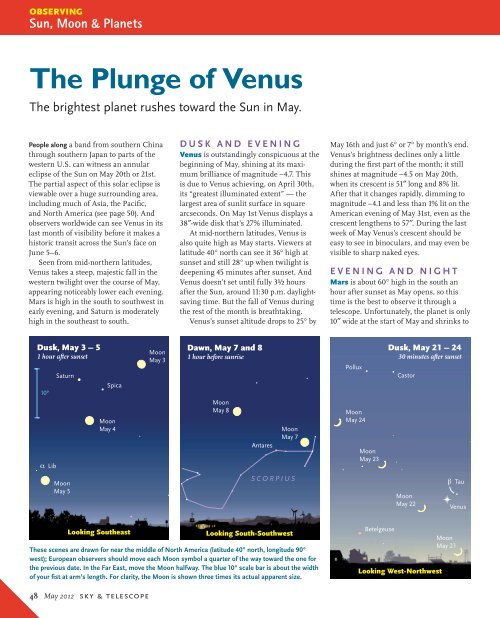Download this ebook as PDF - E-Book Library
Download this ebook as PDF - E-Book Library
Download this ebook as PDF - E-Book Library
You also want an ePaper? Increase the reach of your titles
YUMPU automatically turns print PDFs into web optimized ePapers that Google loves.
OBSERVING<br />
Sun, OBSERVING Moon & PlanetsApril’s<br />
Sun, Moon & Planets<br />
The Plunge of Venus<br />
The brightest planet rushes toward the Sun in May.<br />
People along a band from southern China<br />
through southern Japan to parts of the<br />
western U.S. can witness an annular<br />
eclipse of the Sun on May 20th or 21st.<br />
The partial <strong>as</strong>pect of <strong>this</strong> solar eclipse is<br />
viewable over a huge surrounding area,<br />
including much of Asia, the Pacifi c,<br />
and North America (see page 50). And<br />
observers worldwide can see Venus in its<br />
l<strong>as</strong>t month of visibility before it makes a<br />
historic transit across the Sun’s face on<br />
June 5–6.<br />
Seen from mid-northern latitudes,<br />
Venus takes a steep, majestic fall in the<br />
western twilight over the course of May,<br />
appearing noticeably lower each evening.<br />
Mars is high in the south to southwest in<br />
early evening, and Saturn is moderately<br />
high in the southe<strong>as</strong>t to south.<br />
Dusk, May 3 – 5<br />
1 hour after sunset<br />
10°<br />
Lib<br />
Saturn<br />
Moon<br />
May 5<br />
Spica<br />
Moon<br />
May 4<br />
Looking Southe<strong>as</strong>t<br />
48 May 2012 sky & telescope<br />
Moon<br />
May 3<br />
DUSK AND EVENING<br />
Venus is outstandingly conspicuous at the<br />
beginning of May, shining at its maximum<br />
brilliance of magnitude –4.7. This<br />
is due to Venus achieving, on April 30th,<br />
its “greatest illuminated extent” — the<br />
largest area of sunlit surface in square<br />
arcseconds. On May 1st Venus displays a<br />
38″-wide disk that’s 27% illuminated.<br />
At mid-northern latitudes, Venus is<br />
also quite high <strong>as</strong> May starts. Viewers at<br />
latitude 40° north can see it 36° high at<br />
sunset and still 28° up when twilight is<br />
deepening 45 minutes after sunset. And<br />
Venus doesn’t set until fully 3½ hours<br />
after the Sun, around 11:30 p.m. daylightsaving<br />
time. But the fall of Venus during<br />
the rest of the month is breathtaking.<br />
Venus’s sunset altitude drops to 25° by<br />
Dawn, May 7 and 8<br />
1 hour before sunrise<br />
Moon<br />
May 8<br />
Antares<br />
Moon<br />
May 7<br />
SCORPIUS<br />
Looking South-Southwest<br />
These scenes are drawn for near the middle of North America (latitude 40° north, longitude 90°<br />
west); European observers should move each Moon symbol a quarter of the way toward the one for<br />
the previous date. In the Far E<strong>as</strong>t, move the Moon halfway. The blue 10° scale bar is about the width<br />
of your fi st at arm’s length. For clarity, the Moon is shown three times its actual apparent size.<br />
May 16th and just 6° or 7° by month’s end.<br />
Venus’s brightness declines only a little<br />
during the fi rst part of the month; it still<br />
shines at magnitude –4.5 on May 20th,<br />
when its crescent is 51″ long and 8% lit.<br />
After that it changes rapidly, dimming to<br />
magnitude –4.1 and less than 1% lit on the<br />
American evening of May 31st, even <strong>as</strong> the<br />
crescent lengthens to 57″. During the l<strong>as</strong>t<br />
week of May Venus’s crescent should be<br />
e<strong>as</strong>y to see in binoculars, and may even be<br />
visible to sharp naked eyes.<br />
EVENING AND NIGHT<br />
Mars is about 60° high in the south an<br />
hour after sunset <strong>as</strong> May opens, so <strong>this</strong><br />
time is the best to observe it through a<br />
telescope. Unfortunately, the planet is only<br />
10″ wide at the start of May and shrinks to<br />
Pollux<br />
Moon<br />
May 24<br />
Moon<br />
May 23<br />
Betelgeuse<br />
Dusk, May 21 – 24<br />
30 minutes after sunset<br />
C<strong>as</strong>tor<br />
Moon<br />
May 22<br />
Looking West-Northwest<br />
Tau<br />
Moon<br />
May 21<br />
Venus


